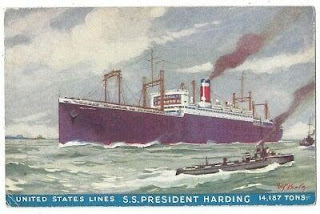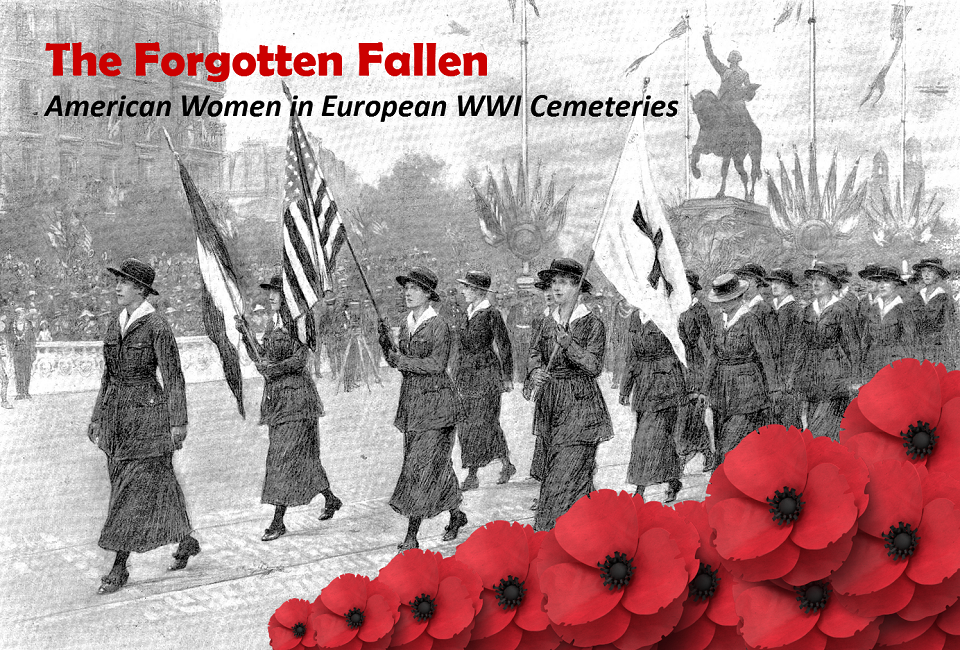Special thanks to Chery Kinnick, herself of Norwegian descent,
and author of the blog, Nordic Blue, who contributed this entry.
 |
| Esther Amundson Find a Grave Memorial |
Just as westward focused pioneers faced leaving fallen loved ones along dusty and forlorn trails leading into the unknown, so it has always been with the parents and spouses of war heroes who die overseas in the service of their country. Otelie Amundson, the mother of Esther Amundson, a volunteer Red Cross Nurse for the U.S. Army, had a tough choice to make after receiving news of her daughter’s death in Mars-sur-Allier, France on October 20, 1918.1
Esther Amundson, born to Amund I. Amundson and his wife, Otelie (Otterson) Amundson on January 3, 1888, was the second of twelve children. The Amundsons’ Norwegian-American family lived in Sparta Township and the town of Montevideo in Chippewa County, southwestern Minnesota.1,2 The community was built around farmlands and prairies, located in a double river valley where the Minnesota and Chippewa rivers converge. Many Norwegians were drawn to the area after the passing of the Homestead Act of 1862. Esther’s birth occurred during the last days of what is commonly known as the “Children’s Blizzard”—a deadly and unrelenting storm that pummeled many midwestern states during the winter of 1887-1888.
A lovely tribute to Esther Amundson has been written by Katie Craven of Saint Paul Public Schools, as part of a National History Day “Silent Heroes” project. The website, which includes details of Esther’s life, intriguing photographs, and a video eulogy, can be viewed here.
“if grippe [influenza] condemns, the secondary infections execute.”
–Louis Cruveilhier, 1919.3
 |
| St. Mihiel American Cemetery at Thiaucourt, France. The crosses were later replaced with Carrera marble.8 |
Esther Amundson fell ill with influenza after serving for less than two months at Base Hospital 35 at Mars-sur-Allier in central France. The cause of her death is listed as lobar pneumonia, which is a secondary bacterial infection. During the Spanish Flu pandemic of 1918-1919, as with other pandemics, bacterial infections often pair with influenza and result in the patient’s death. The “Spanish Flu” is now thought to have originated in the United States. Beginning in April 1918, several months before Esther reported for overseas duty, influenza swept across Europe after arriving on American transport ships at the port of Brest, France.3,4 Esther was buried by American military personnel near where she was hospitalized. After being laid to rest in a foreign land, the rest of the story becomes one of a parent’s grief and longing.
On the homefront, there were differing opinions about whether or not to bring war dead back to the United States. By the time World War I ended, U.S. military leaders balked at the time and expense to deal with over 70,000 buried in temporary battlefield graves. U.S. Allies were reportedly horrified at the idea of Americans digging up their dead and shipping them home, and French leaders actually banned the removal of bodies until late in 1920. There were American leaders who spoke to the glory of leaving fallen war heroes next to their comrades on the battlefield. Former President Theodore Roosevelt and his wife, Edith, opted to leave the remains of their son, Quentin, overseas. “To us it is painful and harrowing long after death to move the poor body from which the soul has fled,” they offered. Still, there were thousands of Americans who demanded the option of bringing home their deceased loved ones.5 Perhaps by default, Esther’s parents opted to leave her remains in France. A request for the disposition of her body does not appear to have been placed.
In a letter dated January 29, 1919, Amund Amundson wrote to the Graves Registration Service in France asking for a photograph of his daughter’s grave and a description of its exact location. Buried the day after her death, Esther’s original battle area grave location was at Mars-sur-Allier, France. It is uncertain if Esther’s parents knew that her remains were actually disinterred twice. All or portions of the original battlefield graveyard became flooded. On June 13, 1919, military personnel relocated her coffin, and presumably those of others, to a location about twelve miles away at Nevers, France. The second disinterment occurred on December 19, 1921, for shipment to St. Mihiel American Military Cemetery, about 250 miles away. The final interment was made on July 10, 1922.1
Within a few years of being widowed, Otelie Amundson had an opportunity to visit her daughter’s grave by participating in the Gold Star Pilgrimage. In 1929, the U.S. Congress passed an act allowing pilgrimages to be organized for mothers and widows of fallen service personnel to visit the graves of their loved ones in Europe. Between May 1930—October 1933, 6,693 women embarked for Europe with all expenses paid.6
 |
| S.S. President Harding, vintage postcard view |
Otelie shared a cabin with another Gold Star Mother aboard the S.S. President Harding, which docked at Cherbourg, France on July 16. From July 17-19, the women attended conferences and visited the Arc de Triumph and Sacre Coeur. Party “I” then left Paris for Verdun, and from July 20-22, engaged in daily trips to St. Mihiel Cemetery. The St. Mihiel American Cemetery in Thiaucourt, France was officially dedicated a few years later, in 1937. The grave of Esther Amundson is one of 4153 burials located on over forty acres. “Beyond the burial area to the south is the white stone memorial consisting of a small chapel, a peristyle with a large rose-granite funeral urn at its center, and a map building. The chapel contains a beautiful mosaic portraying an angel sheathing his sword.”1,7
 |
| Original Wooden Marker Find a Grave Memorial |
On July 23, Otelie’s traveling party returned to Paris for more sightseeing. The group visited Notre Dame, Chateau-Thierry, Napoleon’s tomb, and also enjoyed a nighttime tour of the “City of Light.” Everyone had the option to attend a church service on Sunday, July 26th, followed by more tourist activity, including the Colonial Exposition and Versailles. While in Paris, the women had plenty of free time to relax at their hotel, enjoy conversation with each other, or explore the city on their own. On July 30, Otelie departed Cherbourg harbor on the SS America. After a month away from home, she arrived back in New York harbor on August 7. She was in good health and relieved that she had finally been able to pay her respects to her daughter in person.1
The importance of the contributions and sacrifices made by wartime service personnel cannot be overstated. Aged only thirty years at the time of her death, Esther Amundson still had much life to look forward to. Ironically, a dedication to nursing and helping others led to the unfortunate circumstances of her death. If she had it to do all over again, would she make the same choices? In all likelihood, the answer would be: “Yes.”
References:
- Esther Amundson, World War I Burial Case File; Correspondence, Reports, Telegrams, Applications and Other Papers relating to Burials of Service Personnel, Records of the Quartermaster General’s Office, 1915-1935, Record Group 92; National Archives and Records Administration - St. Louis.
- Amundson family, 1905 Minnesota census, Chippewa County, Sparta Township, Sheet 1. Ancestry.com. Minnesota, Territorial and State Censuses, 1849-1905 [database on-line]. Provo, UT, USA: Ancestry.com Operations Inc, 2007.
- David M. Morens, Jeffery K. Taubenberger, and Anthony S. Fauci. “Predominant Role of Bacterial Pneumonia as a Cause of Death in Pandemic Influenza: Implications for Pandemic Influenza Preparedness” (Abstract from Journal of Infectious Diseases, October 1, 2008, pp.962-970). NCBI, https://www.ncbi.nlm.nih.gov/pmc/articles/PMC2599911/ (accessed July 18, 2020).
- Frederick Holmes, MD. “The Influenza Pandemic and The War.” Medicine in the First World War, The University of Kansas medical Center, http://www.kumc.edu/wwi/medicine/influenza.html (accessed July 18, 2020).
- Drew Lindsay. “Rest in Peace? Bringing Home U.S. War Dead.” HistoryNet, Winter 2013. https://www.historynet.com/rest-in-peace-bringing-home-u-s-war-dead.htm (accessed July 18, 2020).
- Constance Potter. “World War I Gold Star Mothers Pilgrimages, Part 2.” Prologue Magazine, vol. 31, no.3, Fall 1999. World War I Gold Star Mothers Pilgrimages, Part 1 & 2 (National Archives): https://www.archives.gov/publications/prologue/1999/fall/gold-star-mothers.html (accessed Julyl 18, 2020).
- American Battle Monuments Commission. St. Mihiel American Cemetery, http://www.abmc.gov/cemeteries-memorials/europe/st-mihiel-american-cemetery#gallery-anchor (accessed July 18, 2020).
- The Americans in the Great War, Vol. II, The Battle of Saint Mihiel, series: Illustrated Michelin Guide to the Battlefields, 1914-1918. (Clermont-Ferrand, France: Michelin & Cie), 1919.
Copyright 2020 by Chery Kinnick, The Forgotten Fallen. All Rights Reserved.

No comments:
Post a Comment